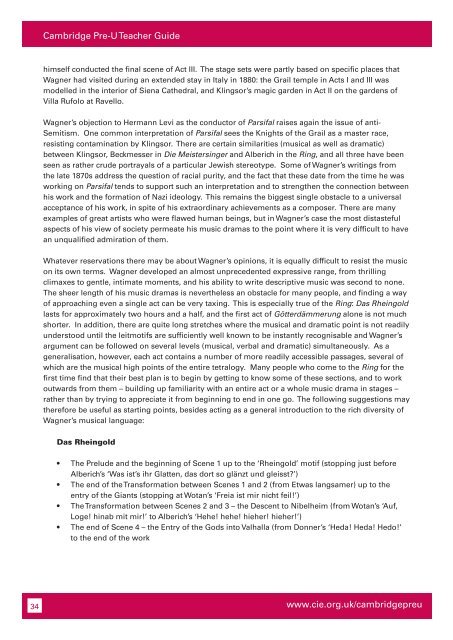Teacher's Guide Cambridge Pre-U MUSIC Available for teaching ...
Teacher's Guide Cambridge Pre-U MUSIC Available for teaching ...
Teacher's Guide Cambridge Pre-U MUSIC Available for teaching ...
You also want an ePaper? Increase the reach of your titles
YUMPU automatically turns print PDFs into web optimized ePapers that Google loves.
34<br />
<strong>Cambridge</strong> <strong>Pre</strong>-U Teacher <strong>Guide</strong><br />
himself conducted the final scene of Act III. The stage sets were partly based on specific places that<br />
Wagner had visited during an extended stay in Italy in 1880: the Grail temple in Acts I and III was<br />
modelled in the interior of Siena Cathedral, and Klingsor’s magic garden in Act II on the gardens of<br />
Villa Rufolo at Ravello.<br />
Wagner’s objection to Hermann Levi as the conductor of Parsifal raises again the issue of anti-<br />
Semitism. One common interpretation of Parsifal sees the Knights of the Grail as a master race,<br />
resisting contamination by Klingsor. There are certain similarities (musical as well as dramatic)<br />
between Klingsor, Beckmesser in Die Meistersinger and Alberich in the Ring, and all three have been<br />
seen as rather crude portrayals of a particular Jewish stereotype. Some of Wagner’s writings from<br />
the late 1870s address the question of racial purity, and the fact that these date from the time he was<br />
working on Parsifal tends to support such an interpretation and to strengthen the connection between<br />
his work and the <strong>for</strong>mation of Nazi ideology. This remains the biggest single obstacle to a universal<br />
acceptance of his work, in spite of his extraordinary achievements as a composer. There are many<br />
examples of great artists who were flawed human beings, but in Wagner’s case the most distasteful<br />
aspects of his view of society permeate his music dramas to the point where it is very difficult to have<br />
an unqualified admiration of them.<br />
Whatever reservations there may be about Wagner’s opinions, it is equally difficult to resist the music<br />
on its own terms. Wagner developed an almost unprecedented expressive range, from thrilling<br />
climaxes to gentle, intimate moments, and his ability to write descriptive music was second to none.<br />
The sheer length of his music dramas is nevertheless an obstacle <strong>for</strong> many people, and finding a way<br />
of approaching even a single act can be very taxing. This is especially true of the Ring: Das Rheingold<br />
lasts <strong>for</strong> approximately two hours and a half, and the first act of Götterdämmerung alone is not much<br />
shorter. In addition, there are quite long stretches where the musical and dramatic point is not readily<br />
understood until the leitmotifs are sufficiently well known to be instantly recognisable and Wagner’s<br />
argument can be followed on several levels (musical, verbal and dramatic) simultaneously. As a<br />
generalisation, however, each act contains a number of more readily accessible passages, several of<br />
which are the musical high points of the entire tetralogy. Many people who come to the Ring <strong>for</strong> the<br />
first time find that their best plan is to begin by getting to know some of these sections, and to work<br />
outwards from them – building up familiarity with an entire act or a whole music drama in stages –<br />
rather than by trying to appreciate it from beginning to end in one go. The following suggestions may<br />
there<strong>for</strong>e be useful as starting points, besides acting as a general introduction to the rich diversity of<br />
Wagner’s musical language:<br />
Das Rheingold<br />
•<br />
•<br />
•<br />
•<br />
The <strong>Pre</strong>lude and the beginning of Scene 1 up to the ‘Rheingold’ motif (stopping just be<strong>for</strong>e<br />
Alberich’s ‘Was ist’s ihr Glatten, das dort so glänzt und gleisst?’)<br />
The end of the Trans<strong>for</strong>mation between Scenes 1 and 2 (from Etwas langsamer) up to the<br />
entry of the Giants (stopping at Wotan’s ‘Freia ist mir nicht feil!’)<br />
The Trans<strong>for</strong>mation between Scenes 2 and 3 – the Descent to Nibelheim (from Wotan’s ‘Auf,<br />
Loge! hinab mit mir!’ to Alberich’s ‘Hehe! hehe! hieher! hieher!’)<br />
The end of Scene 4 – the Entry of the Gods into Valhalla (from Donner’s ‘Heda! Heda! Hedo!’<br />
to the end of the work<br />
www.cie.org.uk/cambridgepreu
















